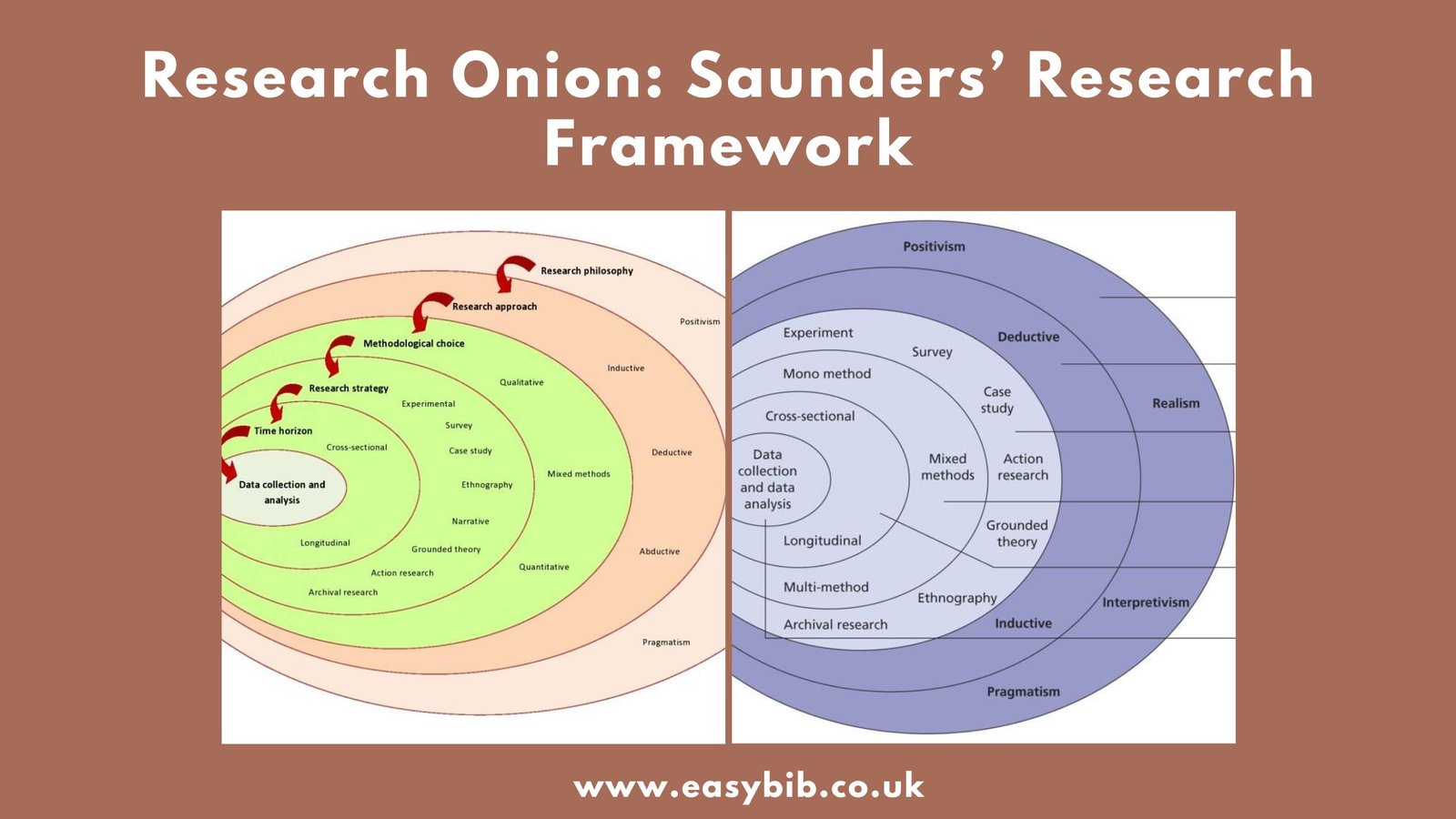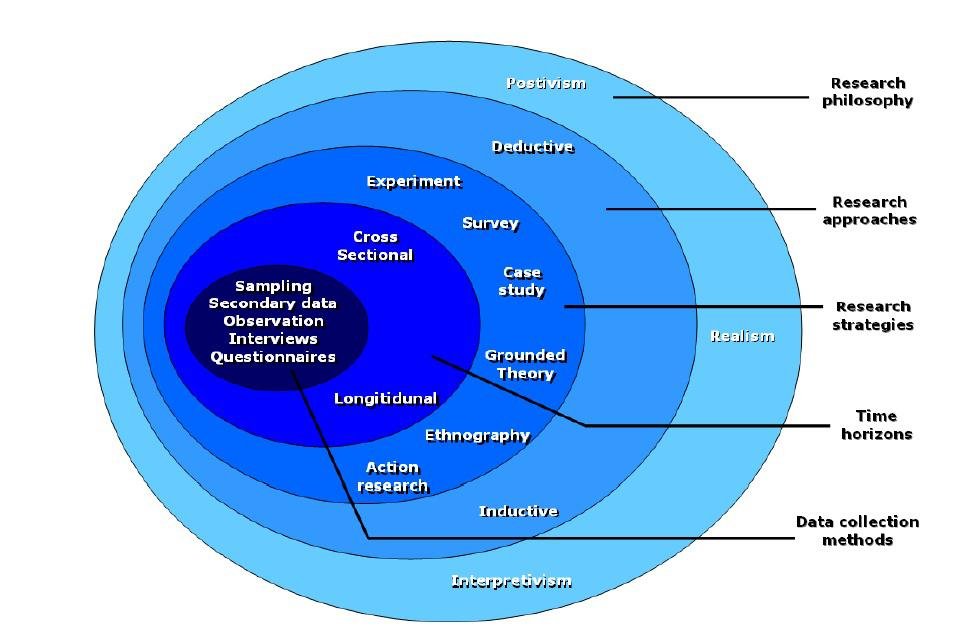Research Onion: Saunders’ Research Framework

The Research Onion is a framework developed by Saunders, Lewis, and Thornhill in 2007. It helps researchers design and structure their studies in a logical and organized way. The model presents the research process in layers, similar to the layers of an onion. Each layer represents a stage that guides the researcher from the outermost philosophical decisions to the innermost data collection techniques.
This framework is widely used in business, management, and social science research. It encourages a clear and systematic approach, ensuring that every step is connected to the study’s objectives. By using the Research Onion, researchers can plan their studies with consistency, depth, and academic rigor.
Understanding the Research Onion Model
The Research Onion model provides a visual and conceptual structure for research design. It divides the process into several layers that must be carefully “peeled” one by one. Each layer influences the next, starting with broader philosophical choices and narrowing down to practical methods and analysis.
The six key layers of the Research Onion are:
- Research Philosophy
- Research Approach
- Research Strategy
- Research Choices
- Time Horizon
- Techniques and Procedures
This structured model ensures that the research process flows logically. It helps researchers make clear, well-justified decisions and align their methods with their research goals.
Research Philosophy
The outermost layer of the Research Onion is the research philosophy. It defines the researcher’s view of the world and how knowledge is created. Research philosophy shapes the overall direction of the study and influences every methodological choice that follows.
Types of Research Philosophies
Saunders identifies four main research philosophies.
- Positivism: This philosophy relies on facts, observation, and measurable outcomes. It is often used in scientific and quantitative research.
- Interpretivism: This focuses on understanding social phenomena and human behavior. It is common in qualitative research, where meaning and context are essential.
- Realism: Realism combines both objective and subjective perspectives. It recognizes that reality exists independently but can be interpreted differently by individuals.
- Pragmatism: This philosophy emphasizes practical solutions. It allows researchers to use multiple methods depending on what best answers the research question.
Selecting a suitable philosophy helps ensure that the entire research design remains coherent and credible.
Research Approach
The second layer of the Research Onion is the research approach. It defines how the researcher connects theory and data. This step is crucial because it determines whether the study will test existing theories or build new ones.
There are three main approaches.
- Deductive Approach: This approach starts with an existing theory or hypothesis and tests it using data. It is often used in quantitative research and follows a logical structure.
- Inductive Approach: This begins with data collection and uses findings to develop new theories. It is common in qualitative research where patterns emerge from observation.
- Abductive Approach: This combines both deduction and induction. It allows the researcher to move back and forth between data and theory for a deeper understanding.
Choosing the right approach helps maintain a clear link between research questions, theory, and findings.
Research Strategy
The research strategy layer focuses on how the study will be conducted. It describes the plan for collecting and analyzing data. Saunders identifies several strategies that researchers can use based on their goals and philosophy.
- Experiment: This strategy tests hypotheses in a controlled environment and is common in scientific research.
- Survey: Surveys gather data from a large population using questionnaires or interviews. They are often used in descriptive and quantitative studies.
- Case Study: This strategy provides an in-depth understanding of a single case, organization, or event. It allows for detailed exploration of complex issues.
- Action Research: This involves solving real-world problems while simultaneously generating new knowledge.
- Grounded Theory: This builds new theories directly from the data collected during the research.
- Ethnography: Ethnographic research studies people within their natural settings to understand cultures and behaviors.
- Archival Research: This uses existing records or historical data for analysis.
The right strategy ensures that data collection aligns with the purpose and scope of the study.
Research Choices
The next layer is research choices. It refers to how the researcher combines data collection methods and analysis techniques. Saunders classifies them into three main types.
- Mono Method: This uses one type of data collection, such as only quantitative or only qualitative.
- Multi-Method: This applies more than one technique within the same approach, such as using multiple qualitative methods.
- Mixed Methods: This combines both qualitative and quantitative approaches in the same study.
Mixed methods are increasingly popular because they provide richer data and allow researchers to cross-verify their findings.
Time Horizon
The time horizon layer defines the time frame of the study. It determines whether the research captures a single moment or examines changes over time.
- Cross-Sectional Studies: These studies collect data at one point in time. They are efficient and suitable for analyzing current situations.
- Longitudinal Studies: These collect data over a longer period. They are used to study trends, developments, and changes over time.
The choice of time horizon depends on the research objectives, resources, and available time. Longitudinal studies offer deeper insights but require more effort and planning.
Techniques and Procedures
At the core of the Research Onion are the techniques and procedures. This is the practical stage where the researcher collects and analyzes data. The methods chosen must align with the previous layers to ensure validity and reliability.
Common data collection methods include surveys, interviews, focus groups, and observations. Quantitative research may use numerical data and statistical tools, while qualitative research focuses on themes, patterns, and meanings.
Data analysis techniques vary according to the type of research. Statistical analysis is common in quantitative studies, while thematic or content analysis is used for qualitative data. Ethical considerations are also vital during this stage to protect participants and maintain research integrity.
The Research Onion Diagram

The Research Onion diagram visually represents the entire model. It shows how each layer fits within the others, guiding researchers from philosophy to practice. The diagram helps visualize the sequence of decisions needed to design a complete research study.
The outer layers represent abstract thinking, while the inner layers focus on application. This structure makes the research process clear, systematic, and easy to follow.
Advantages of Using the Research Onion
The Research Onion provides structure and clarity to research design. It helps researchers make consistent decisions at each stage of the process. By following the layers, they can ensure that their study remains logically organized and academically sound.
It also improves transparency. Readers and examiners can see how each decision leads to the next. The model simplifies complex research concepts and provides a clear framework for developing methodology sections in dissertations or reports.
Conclusion
The Saunders Research Onion is a valuable tool for anyone conducting academic or professional research. It offers a clear roadmap that leads from philosophical foundations to data collection and analysis. Each layer contributes to building a strong, coherent, and credible study.
By understanding and applying this framework, researchers can produce structured, reliable, and well-justified research designs. The Research Onion remains one of the most influential models in modern research methodology and continues to guide students, academics, and professionals worldwide.
